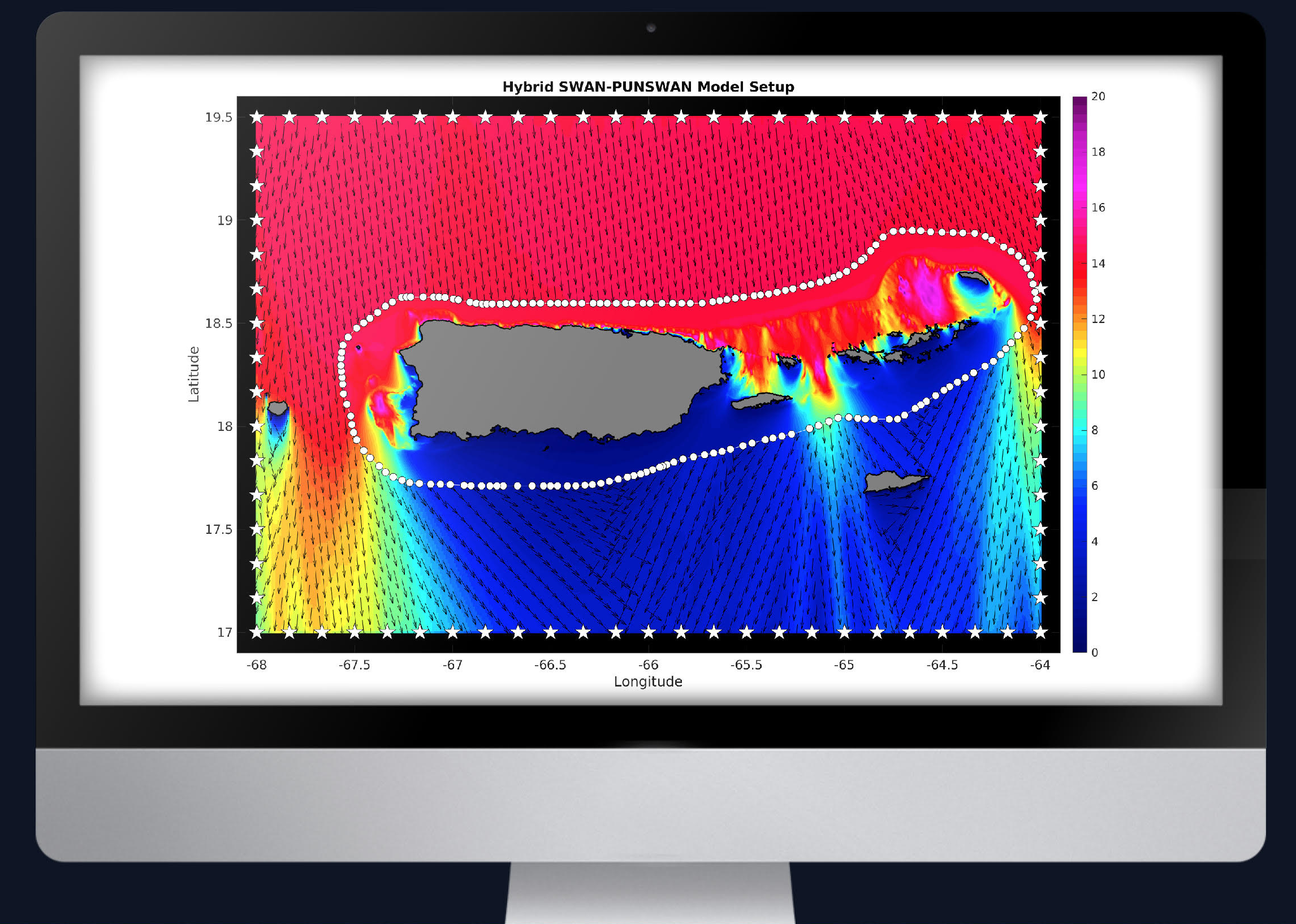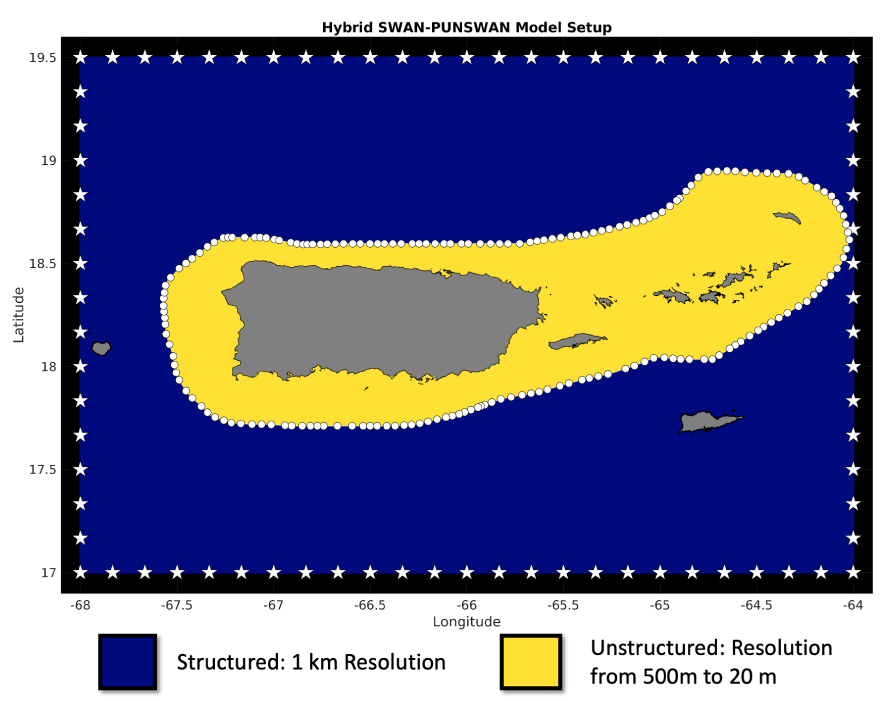For the present study we have carried out a 40-year high-resolution wave climate simulation based on the Simulating Waves Nearshore (SWAN) spectral wave model, which is described in detail in (Booij et al., 1999) and (The SWAN Team, 2012). Details of the setup and validation of the CARICOOS Nearshore Wave Model, a similar model developed by CARICOOS Co-PI Miguel Canals, may be found in Anselmi et al. (2012), Canals et al. (2012) and Canals and García (2019). SWAN is a state of the art spectral wave model which takes into account the effects of wave shoaling, diffraction and refraction, nonlinear wave-wave interactions (triads and quadruplets), and dissipation due to wave breaking and bottom friction. A brief description of the model setup and surface and boundary forcing data sources is provided below.
Model mesh and setup
A schematic of the model setup is shown in Figure 1.
We use a hybrid approach combining a coarse structured SWAN grid at 1 kilometer resolution with an unstructured mesh around Puerto Rico and most of the USVI. The blue area shows the structured SWAN grid at 1-kilometer resolution. This coarse structured grid obtains boundary conditions from the regional NOAA NCEP Multigrid WaveWatch III Model (Chawla et al., 2013) in the form of 2D wave spectra at the locations shown as white stars.
The yellow area shows the footprint of the unstructured SWAN mesh, which is nested within the structured SWAN model and which obtains 2D spectral boundary conditions from the structured SWAN grid at the locations indicated by white circles. The unstructured mesh was developed using the Oceanmesh 2D MATLAB package (Roberts et al., 2019).
The mesh resolution varies from 500 meters in deep water to 20 meters very close to the shoreline.
The mesh bathymetry is obtained from the NOAA Continuously Updated, 1/9th arc-second Digital Elevation Model that was developed using 2016 and 2018 LIDAR data and single and multibeam bathymetry data. Figure 2 shows the mesh bathymetry (top) and spatial resolution (bottom).
The SWAN model resolves wave transformation in spectral space by solving the spectral energy balance equation which describes the evolution of the 2D wave spectrum (frequency and direction) at each computational node. The directional resolution is 5 degrees and the frequency spectrum is divided into 36 bins with frequencies ranging from 0.04 Hz to 0.667 Hz, allowing the model to resolve waves with wave periods between 1.5 and 25 seconds. The SWAN model is run in third generation mode, which includes model physics such as quadruplet interactions, exponential wind wave growth and white-capping (The SWAN Team, 2012). Model physics also include wave energy dissipation due to bottom friction using the JONSWAP formulation, triad wave interactions, diffraction and depth-induced wave breaking (The SWAN Team, 2012).
Spectral boundary conditions
To capture far field wave conditions, spectral boundary conditions in the form of two-dimensional wave spectra are applied at the structured SWAN model boundaries using output from the NCEP NOAA NCEP Multigrid WaveWatch III Model Chawla et al. (2013).
For the period between 1979-2009 spectral boundary conditions were obtained from the NCEP WW3 Phase 2 waves hindcast.
This 30 year wave climatology hindcast was performed using winds from the NCEP Climate Forecast System Reanalysis and Reforecast (CF10SRR) homogeneous dataset of hourly high-resolution winds.
For simulations beyond 2009 to present, spectral boundary conditions were obtained from NCEP’s wave model production hindcast, which uses wind input from NOAA’s operational Global Forecast System (GFS) weather model. This spectral forcing has been previously shown to provide very good results for nearshore SWAN modeling in Puerto Rico and the US Virgin Islands (e.g. Anselmi et al., 2012; Canals and García, 2019).
surface boundary conditions
Surface wind forcing was provided to the model using output from the NCEP Climate Forecast System Reanalysis and Reforecast (CFSRR) dataset of hourly high-resolution winds at an approximate resolution of 38 km. It should be noted that the wave model hindcasts described above use global scale weather models with spatial resolution on the order of 25 km. Such weather models describe with good accuracy the wind patterns at regional and basin scales, but do not accurately describe the small scale structure of intense tropical cyclones. To take into account the effects of hurricanes and tropical storms into the hindcast, the 40-year period was partitioned into periods with and without named storm events in the vicinity of the model domain. Periods with named storms were identified using the National Hurricane Center’s HURDAT2 best track hurricane database. For these events and time periods, the wind forcing for the simulation was obtained using the Generalized Asymmetric Holland Vortex Model, constructed using the hurricane parameters from the HURDAT2 database. This wind model has been used extensively for hurricane storm surge and wave simulations. For Hurricanes Irma and María, HWRF model output produced by NOAA/NHC/NCEP was used as surface boundary conditions.
The model was run from January 1, 1979 to December 31, 2018 and separated into month-long runs in hot-start mode. After each month-long simulation, the next simulation is restarted using a 2D spectral hot-start file produced at the end of the previous simulation. The figure below shows an example of the output from the hybrid SWAN simulations, in this case for March 6, 2018 (Winter Storm Riley). Colors represent significant wave height in feet and the arrows represent wave direction (wave direction shown for coarse structured grid only).














